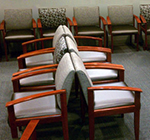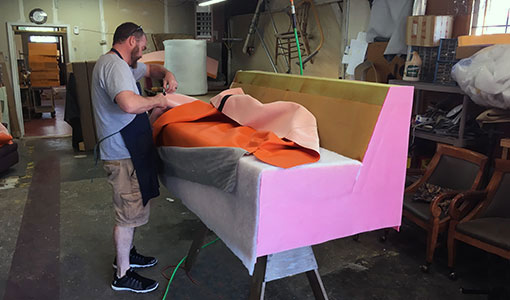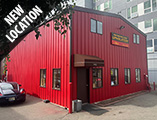Upholstery Seattle is the regional leader in reupholstering lobby and guest room furniture. We're also tops in hotel upholstery, bar upholstery and pub upholstery. If you need a bar stool reupholstered, give us a call. Our craftsmen fabricate custom cushions, pillows, and window coverings for businesses and commercial clients.
Visit our showroom in Ballard to compare and price the latest commercial grade leathers, fabrics and foams.
We serve some of the world's largest fishing fleets and cruise ship lines, including Holland America and Trident Seafoods. Find out why these large corporate clients trust Upholstery Seattle to deliver quality services on-time.
We also feature a vast selection of standard fabrics specifically manufactured for commercial purposes. These contract fabrics are durable, easy to care for, and guaranteed to last.
Call Upholstery Seattle for restaurant upholstery, restaurant upholstery repair and commercial furniture upholstery. Pick up and delivery service is available. Call 206-783-1696 to schedule your free estimate or visit our new showroom adjacent to Mac’s Upholstery at 5011 15th Avenue NW in Ballard.
Upholstery Seattle Commercial Projects
Marriott Waterfront Seating Ottoman
Transforming the mundane into the extraordinary, Upholstery Seattle's skilled craftsmen have woven their magic once again, this time gracing the Marriott Waterfront in Seattle with a dazzling revival. A colossal seating ottoman, weathered by time and use, found its redemption in the hands of our artisans. The Symphony Classic, in the sophisticated hue of buff, became its second skin—a superior-quality, pebble-grained vinyl that not only boasts the aesthetics of leather but also promises durability beyond compare.
The devil lies in the details, and in this case, it's the subtle French-style stitching that elevates the ottoman's allure, turning it into a statement piece that seamlessly merges with the Marriott's upscale ambiance. Our commitment to excellence didn't stop at aesthetics; recognizing the longevity of the ottoman's core, we judiciously preserved the upholstery foam while bestowing a fresh layer of Dacron padding. The result? A harmonious blend of comfort and style, beckoning guests to indulge in the lap of luxury.
Upholstery Seattle's passion for restoration goes beyond mere craftsmanship—it's a testament to our dedication to transforming spaces, one piece at a time. In the heart of Seattle's Marriott Waterfront, our revitalized ottoman stands as a beacon of timeless elegance, inviting patrons to experience the epitome of refined comfort.
Filson's calling card has always been the durable tin cloth fabric it uses to manufacture traditional work trousers and outer wear. Somebody in its marketing department came up with a great idea; use a patchwork of old tin cloth trousers to upholster the new bench.
As you'd expect, the patchwork fabric Filson provided was in great shape. Some of the thick seams were doubled-up, which made sewing a little tricky in places. But, aside from that, the fabric worked perfectly. Since the bench was designed for a retail store, we recommended four inch HR-55 polyurethane foam; it's a stiffer foam that the typically stuff used on home furniture. Next time you're in Filson's flagship store near T-Mobile Park, check out the large tin cloth bench. We think it's pretty cool!
Restore Harvey Probber Furniture
Probber's breakthrough family of modular furniture consisted of nineteen different elements that could be assembled into any desired seating configuration. His work was chosen for MoMA’s Good Design exhibition in 1951. Vintage Probber furniture is still enormously popular.
A customer recently brought us five Probber chairs that were showing their age. The plastic bases were scuffed and the fabric was ragged, but the more immediate problem was aging foam. Ultraviolet light and years of wear had damaged the foam, especially the crown of the backrest.
If this were any other chair, we'd simply strip the old foam and replace it with commercial quality polyurethane. We couldn't do that with these chairs because the foam was molded into the steel tube frame and spring box when it was manufactured. The process is called cold pressing.
Fortunately, the foam base was in good shape. After consulting the owner, we carefully removed the damaged crown and replaced it with medium density HR33 polyurethane wrapped in foam scrim.
Despite the modifications, the cushions remain the same size, so we were able to pattern new covers from the old ones. The commercial grade blended upholstery fabric we used matches the original color, but it's quite a bit more durable and has a coarser weave. The restored Probber chairs look great and should stay comfortable for decades.
Generally speaking, furniture from Ikea is not worth reupholstering. Most of their stuff is so cheap you can buy a brand new chair for what it costs to recover the old one. But, if you like a specific Ikea chair and it's not being manufactured anymore, reupholstery is an excellent choice.
This vintage Ikea office chair is a cross between a 70s pod chair and a pedestal swivel. It's perfect for office use.
The owner loved the chair, but not the fabric. She wanted it recovered in a solid blue microfiber. Microfiber looks and feels great. Unfortunately, it's a relatively stiff fabric. Ideally, you want something with plenty of "give" when upholstering curved furniture. If it's too stiff you get wrinkles.
Pleats eliminate wrinkles, but they clash with the sleek and simple design of a chair like this. A better alternative is steam. Steam temporarily loosens a fabric's weave allowing a tighter fit around curves.
Steaming did the trick. As you can see, the microfiber molded nicely to the old chair.
When David Bowie died in January 2016, the world lost more than a gifted musician and talented actor. Bowie had become a pop icon.
Paul Allen's Museum of Pop Culture, formerly the Experience Music Project, wanted to stage an exhibit documenting his extraordinary life and accomplishments. The exhibit required custom seating and other specialized upholstery work.
The craftsmen at Upholstery Seattle have completed a number of similar projects. The museum's time frame was the only part that proved a little bit challenging; the exhibit was already under construction and they needed a quick turn around. Aside from that, the project went smoothly and the display turned out great.
Standard seating booths tend to be symmetrical. The common angles are not only aesthetically pleasing (in a Main Street sort of way), symmetrical booths fit together even after being moved or reconfigured. But, symmetrical doesn't mean perfect. Not in the real world. Each seat in this booth has slightly different dimensions. As a result, we had to individually pattern all four cushions and seat backs for a seamless fit.
Selecting the proper fabric and foam for a seating booth depends on how it's going to be used. This one is being built for a museum in California, so the fabric needs to be tough and easy to clean. The designer selected Cool Comfort Soleil Vinyl by Architex. A nice choice.
For standard home furniture, we recommend a medium density foam — HR45. It strikes a nice balance between comfort and support. While HR45 is perfect for living room chairs and sofas, it's too soft for this. A foam that provides greater support — HR55 wrapped in Dacron® — is better suited for seating in a public setting.
If you're refinishing or installing booths, drop by our shop. We'll help you do it the right way.
Rubbermaid recently asked us to put the final touches on a wall insert for an office meeting room. The project required us to upholster 50 rectangular panels with foam and fabric then mount them on the interior walls of the insert.
The company selected a durable wool blend fabric — Coda 722 — manufactured by Kvadrat, a Danish design textile firm. Because the booths were u-shaped, nearly half of the panel inserts were curved. Fortunately, the foam had plenty of give and we were able to stretch the fabric enough to upholster the rounded inserts without too much difficulty. Turned out great!
We often upholster chairs for hair salons, spas and barber shops. In this instance we're recovering 32 chairs for a new hair salon in Seattle's Pioneer Square neighborhood. This sort of project can be time consuming, but it's usually pretty straightforward. The tricky part is selecting the right fabric.
The owner of the new Pioneer Square salon operates successful salons and spas throughout the area. Based on his reputation, there'll be plenty of customers from the get-go. It promises to be a busy, upscale business, so both style and durability are important considerations when selecting a fabric.
Today's premium vinyls are almost indistinguishable from leather. We recommended a slightly textured, satin finish black vinyl manufactured by Olympus. In addition to looking great, this vinyl is easy to work with. It's also sturdy -- it's rated 1.5 million double rubs -- and it resists damage from most chemicals found in a hair salon.
This was a rush order; as soon as the fabric arrived, our craftsmen went to work. As you can see, the chairs -- trimmed in matching welt -- turned out great! And by using the right fabric, they'll last for years.
Custom Upholstery Buttons
Custom made upholstery buttons are often used to attach fabric to furniture when a chair or sofa has a curved shape. They're also an excellent way to dress up furniture, especially in an office setting.
Fabricating and attaching the buttons can be tricky and time consuming. But, when done properly they're definitely worth the effort. The process begins by collecting scraps of the upholstery we used to cover the sofa, then cutting the fabric into small squares.
In this case the fabric is a grey polyester chenille. Using a sturdy "cookie cutter" dye, we slice the squares into button-shaped plugs the size of an old silver dollar.
A heavy duty button maker then aligns each fabric plug with a steel button blank and snaps the assembly in place.
Attaching the buttons requires special care, especially when the cushions are spring supported, like the ones on this couch. Being careful not to damage the springs, we thread and tie the custom made buttons. The fabric grain on the buttons should align with the fabric grain on the cushion before the job is done.
Cruise Ship Dining Chairs
Holland America, one of the world's top cruise lines, chose us to renovate a warehouse full of dining room chairs in preparation for its busy summer cruise season. They turned to Upholstery Seattle because reupholstering these rattan chairs is not a job for amateurs. The final step in the process is especially tricky; it requires special tooling and an artist's eye.
The first step is straightforward. Each chair has to be stripped to the frame. This takes a little longer than normal because the fabric is stapled directly to the rattan chairback without the aid of a standard lip or channel. That "missing lip" is what makes the job of reupholstering these chairs so difficult; how do you attach the new fabric without making a mess of things?
As the chairs are being stripped, we cut and stack fabric to fit the padded seats and chairbacks. We also prepare strands of "double-welting" for later use.
The polyurethane padding is in good shape, so in most cases we simply reuse the foam after adding a thin layer of dacron. Stapling the new upholstery fabric to an individual chairback is routine. Covering the seam caused by the row of staples is the hard part.
This is where the double-welting comes in. The bead needs to be "double wide" to cover both the row of staples and the damage caused by another upholstery shop. We could glue the double-welt in place, but there's a better way. Using a special pneumatic gun, we tack the double-welt in place using 18 gauge, quarter inch staples. The staple heads are painted the same color as the fabric so everything blends together. By the time we're done, each of these ratan dining room chairs looks brand new.
Ever wonder why your favorite chair is more comfortable than a nearly identical one? The difference may be thicker padding or better fabric, but often times it comes down to something a lot of upholstery shops ignore; "deck angle".
A chair's deck is the surface that supports the seat cushion. You see flat chair decks on cheap furniture because they're inexpensive to build and upholster. Decks also tend to be flat on Scandanavian style furniture.
Without the reinforcement of a solid "spring edge" or edge roll, the front edge of a flat deck will collapse over time. If that happens, you slide forward when sitting.
When reupholstering an antique chair such as this, we're careful to restore the spring edge first. A properly restored spring edge cants the cushion to create a more comfortable seating angle. It also covers any gap between the cushion and the chair deck. Little things like this make a big difference.
Upholstering Barrel Chairs
Some say the first barrel chair was manufactured from an old wine barrel in Italy. Others trace its origin back to France or the United Kingdom. While the concept is old, the barrel chair enjoyed its heyday during the Mid-Twentieth Century. Restoring these barrel chairs requires a modern fabric that evokes the original look.
The original fabric was a tufted beige chenille. We recommended a slightly darker synthetic chenille reminiscent of the button down Fifties and early Sixties.
Fortunately, the chairs are in great shape. They're sturdy and well made. The tricky part is smoothing the fabric around the tight curves. A couple of upholstery techniques come in handy. To prevent tearing, we slice relief cuts into the fabric allowing it to "hug" the concave chairback. The other problem when covering a barrel chair is fabric "bunching". To prevent bunching we build pleats. The pleats allow the fabric to smooth easily around the swivel base. When finished, the chair remains true to its Mid-Century Modern heritage.
Washington Athletic Club Sectional
Dear Michelle —
I just wanted to say thank you for all of your efforts to get this sofa back to us in a timely manner. The difference is startling and has received many positive comments from the staff. Your guidence in the selection of fabrics was perfect. I love the pillow contrasts especially! Thank you, thank you, thank you!!!— Carl M.
Recycled leather is a relatively new upholstery material. It's animal-friendly and less expensive than new leather. On the other hand, it's not very durable and scratches can be difficult to repair. If you're determined to save money and aren't concerned about wear, recycled leather is worth considering. Here's an example of how we used it to upholster a tufted leather chair.
Aligning and tufting the recycled leather into square-shaped biscuits requires careful measurements and precise sewing. After folding the leather into a rectangle, we sew a curved seam along the inside edge, flip it 90 degrees and repeat the process. A dimple is created where the two seams intersect. In some cases, each dimple is covered with a button. Not this time.
After welting the corners, we're all done. As you can see, it's nearly impossible to tell the difference between recycled leather and "the real thing". Just don't expect it to last as long.
 Many of the region's top businesses trust Upholstery Seattle to deliver quality craftsmanship at a fair price. They include the Washington Athletic Club, Marriott Courtyard, Four Seasons Hotel, Sheraton Downtown, Muckleshoot Casino, Flying Fish, Oceanaire Seafood, Carrillon Point, Imagicorps/Microsoft, Martin Selig Real Estate & the Seattle Aquarium.
Many of the region's top businesses trust Upholstery Seattle to deliver quality craftsmanship at a fair price. They include the Washington Athletic Club, Marriott Courtyard, Four Seasons Hotel, Sheraton Downtown, Muckleshoot Casino, Flying Fish, Oceanaire Seafood, Carrillon Point, Imagicorps/Microsoft, Martin Selig Real Estate & the Seattle Aquarium. Reupholster Office Chair
Reupholster Office Chair Upholstery Seattle provides interior design assistance in selecting the perfect fabric from our large selection of eco-friendly, "green" commercial fabrics for restaurant booths, benches, chairs and stools. Ask about our recycled leather, PVC free and certified "Cradle to Cradle" environmentally friendly fabrics designed with material content, recyclability and manufacturing characteristics in mind.
Upholstery Seattle provides interior design assistance in selecting the perfect fabric from our large selection of eco-friendly, "green" commercial fabrics for restaurant booths, benches, chairs and stools. Ask about our recycled leather, PVC free and certified "Cradle to Cradle" environmentally friendly fabrics designed with material content, recyclability and manufacturing characteristics in mind.







